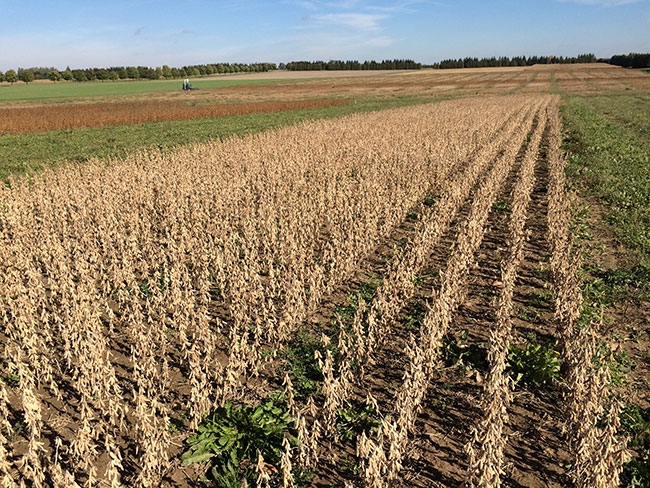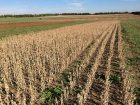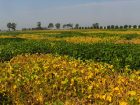
Features
Agronomy
Soybeans
Soybeans of the future
Soybean breeding targeted to Canadian needs has been essential to the growth of soybean production in this country. We asked soybean growers, breeders and others to share their thoughts on what the future might hold for soybean traits.
April 10, 2018 By Carolyn King
 Istvan Rajcan’s soybean breeding program includes work on traits like higher yields Soybean breeding targeted to Canadian needs has been essential to the growth of soybean production in this country.
Istvan Rajcan’s soybean breeding program includes work on traits like higher yields Soybean breeding targeted to Canadian needs has been essential to the growth of soybean production in this country.Tackling crop stresses
“Some of the traits that will be important are related to ensuring sustainable production without losses due to biotic or abiotic stresses,” says Istvan Rajcan, who leads the soybean breeding program at the University of Guelph.
“When I think of abiotic stresses, I think about all the things that are happening to the environment as a result of climate change. To give you a couple of examples, the more volatile climate that is being predicted could lead to intermittent drought or cold or erratic weather patterns that would make growing crops more challenging. A number of breeding programs are working on drought tolerance including my program, and other researchers are working on cold tolerance.”
François Labelle is a farmer and the executive director of the Manitoba Pulse and Soybean Growers. One of his top priorities for soybean traits is drought tolerance. “There are two aspects to that. One is overall drought tolerance, so the plant will survive in dry conditions. But Manitoba often has a dry August, and that is when the beans are filling. So in a dry August, you tend to get lower yields. In my ideal wish list, you’d have a plant that is more tolerant to dry conditions at that time of year.”
“I think we’ll see some weather-related traits whether it’s drought tolerance or a kind of weather tolerance,” says Mark Huston, a farmer, and director with Grain Farmers of Ontario. “And, with the growth we’re seeing in the western provinces and moving north as well as west, we’ll continue to see a focus on breeding soybeans that can grow in shorter-day environments.” He also thinks cold and frost tolerance will be important. “If you can get a soybean that withstands your early-season frosts, then you could start planting it a little earlier and start pushing your yield that way.”
Huston is also chair of Soy Canada, an association that brings together all groups driving the Canadian soybean industry, from the farm to the marketplace.
Rajcan is fairly certain that resistance to biotic stresses, like diseases and insect pests, will continue to be a big part of soybean breeding for many years to come. “We are always in a constant race between the plant and the pathogen. It is referred to as the boom-and-bust cycle. You introduce resistance into a crop and the crop starts thriving because it is resistant and everybody wants to grow it. Then you’re putting so much selection pressure on the pathogen that it overcomes that resistance. And then you’re back to the drawing board.”
A current example of that is soybean cyst nematode. “Most of the breeding programs have been using one source of resistance to this nematode, and there is evidence that the nematode is overcoming that resistance. I expect there will be more emphasis on developing alternative sources of resistance not only to soybean cyst nematode but to other diseases affecting soybean such as Phytophthora root rot and white mould,” explains Rajcan.
For western Canadian growers, Labelle says, “We need to pay attention to emerging pests. For instance, soybean cyst nematode is not an issue yet in Western Canada, but it is only a matter of time. So we need to make sure we continue to have some breeding on that and other issues that could be problems in the future, like soybean aphids, iron chlorosis deficiency, etcetera. As we’re growing more soybeans, we’ll see more of these problems.”
Huston notes, “I think we’re still going to see some herbicide-tolerant traits come forth, especially given what we’re seeing with resistance [as weeds develop resistance to the herbicides used in the current herbicide-tolerant cropping systems].”
More marketable meal
The other top trait on Labelle’s list is increased protein content. “Soybeans are grown for protein for meal to feed animals, and a very high percentage of beans end up in that marketplace,” he says. “Over the years we’ve seen a trend where the protein has been going lower. I understand from the breeders that, as we’re trying to get shorter-season varieties, improving the yield or bringing in resistance to diseases and/or pests, we have been dropping the protein of our soybeans. The lower protein is becoming an issue in the marketplace, and it is probably worse in Western Canada. So we definitely need to improve the protein content.”
“Soybeans are 80 per cent meal and 20 per cent oil. Much of the meal goes to animal feed, and the reason for that is because of the completeness of the proteins in the meal,” says Rob Roe, director of bioproduct commercialization at Oilseed Innovation Partners, an agency that works on pre-commercialization and commercialization of opportunities from Canadian oilseeds like soybeans, canola and sunflower.
Huston says, “We really haven’t seen a lot of development of soybean traits from the standpoint of the ability to get a more useful meal. With many traits, we’ve been trying to generate more and more value for the oil side. But if we can re-solidify soybean meal as the protein of choice for animal feed – perhaps through different amino acid profiles or what have you – then that would increase the value there.”
Roe has observed a growing interest in the broader food processing industry for non-genetically modified (non-GM) soybeans. “I’m not talking about organic soybeans necessarily; I’m talking about soybeans without GM traits. This interest is being driven largely by consumer demands, which are influencing food processors, and that is having an effect on crop commodity processors. We see this in the level of interest in non-GM soybeans for a variety of things like meal for poultry. A non-GM meal is worth more money than meal from a GM variety.”
Rajcan adds, “I think there is a potential that non-GM soybean production will remain significant and stable at about 25 to 30 per cent of the annual soybean production in Ontario and Quebec. That is partly driven by food-grade soybean and partly by the need for non-GM soybean for markets that do not accept genetically modified crops.”
Rajcan has also been involved in an organic soybean breeding project. “At present, a relatively small number of Ontario farmers are growing soybean organically, but in my view that number will likely increase because of the higher value for organic soybeans. Farmers can be paid two times or sometimes three times more for organically grown soybeans.”
According to Rajcan, another trait that might become more important for the meal is low-phytate content. The phosphorus in low-phytate soybeans is more digestible by non-ruminants, like pigs, so more of the phosphorus can be used by the animal and less is excreted in the animal’s manure.
Innovative oil profiles
The final steps in the global regulatory approval for trade of GM high oleic soybeans were recently completed. This opens the door to the expansion of high oleic soybean acres. Roe says, “It’s pretty certain that more high oleic soybean varieties will be developed for North America.” DuPont Pioneer and Monsanto both have high oleic soybeans, plus some smaller companies are developing non-GM high oleic soybeans.
High oleic soybean oil has some definite advantages over regular soybean oil for food uses. Regular soybean oil can be hydrogenated to improve its cooking performance and extend its shelf life, but hydrogenation creates trans fats, which increase the risk of heart disease. High oleic soybean oil has greater heat and oxidative stability, so the oil lasts longer in frying and processed foods have a longer shelf life. Also, the oil is lower in saturated fat content and contains no trans fats.
“High oleic soybean was originally designed as a trait for food uses. But the oil profile also suits itself very well to industrial uses like lubricants and high temperature cutting oils [fluids used in metalworking processes],” Huston says. “I think that type of cross-platform flexibility is going to be pretty vital.”
Roe adds, “With more acres of high oleic soybeans, that feedstock will become more available for things like bio-based lubricants. I think over the next five years, we’re going to see a growth in bio-based lubricants utilizing oils from high oleic oilseeds.”
Rajcan has a project on an industrial use of soybean oil. “We have developed a new soybean variety that has a modified oil composition with close to 70 per cent linoleic acid. That was initially created through mutagenizing soybean seeds with a chemical and some of the seeds happened to have that percentage of linoleic acid. For comparison, normal soybeans have about 53 per cent linoleic acid.” Rajcan and his group identified a particular soybean line with a high linoleic content that was stable under various growing conditions, and then crossed it with high-yielding soybeans to
create the high-linoleic variety.
Roe’s group is exploring the commercialization possibilities of this high linoleic oil for the University of Guelph. However, he emphasizes that development and adoption of new industrial oils from oilseeds can be complex and take quite a while. “Let’s take the example of the high linoleic soybean oil use for finished paints and coatings,” he says.
“Before seed companies produce seed for growers, and the processors can consider crushing and producing a refined soybean oil, the coatings and paint manufacturing value chain requirements need to be addressed. There are additional manufacturing steps before the refined soybean oil can be made into a finished coating or paint. Alkyd resin companies transform the oil into a resin product that is in turn sold to coatings and paint companies for manufacturing into finished products. The resin companies need to be convinced of the oil’s benefits and value to produce a superior alkyd resin product. The resin companies require samples of the new oil, in this case provided by the University of Guelph, to make alkyd resins and paints for evaluation of performance and characterization of the resins made from the new specialty soybean oil. If the results are promising, as it has shown so far, they will work with the coatings and paint companies for further extensive testing and to prove the performance of the finished products. Consider all the steps in the value chain from seed breeding, seed production, crop production, oilseed crushing and refining, alkyd resin production and coatings and paint manufacturing. Each has its technical and economic requirements that must be satisfied. It all takes time.”
Breeding technologies, regulatory aspects
Rajcan and soybean breeder Asheesh Singh at Iowa State University both point to technological advances that are playing an increasing role in breeding of soybeans and other crops. “For instance, there’s high-throughput phenotyping – using technologies that allow breeders to phenotype, or measure traits, in an automated manner using different devices instead of people walking the fields for a long time and collecting data manually,” Rajcan says. “Also, most of the big seed companies are using genomic technologies, genome selection, molecular markers, to advance their breeding programs, and make better predictions about what would be superior new varieties in their selection and breeding programs. As well, gene editing technologies are being pursued.”
According to Rajcan, the combination of these technologies could help make the breeding process “more consistent with less wrong selections because we would be more precise in identifying what we need early in the process.”
“When it comes to breeding technologies, one of the questions is what will happen with the regulatory environment and whether or not we will be able to utilize gene editing tools like CRISPR and zinc-finger nuclease technologies in a non-GM fashion. If we can, that will open up a lot more doors than if we have to go through the traditional regulatory process on GM traits,” notes Huston.
In 2016, the U.S. Department of Agriculture concluded that a CRISPR-edited mushroom would not be regulated like a GM food product because no foreign genetic material had been inserted. But many other regulatory bodies are still considering whether or not to regulate gene-edited foods as GM foods.
“A number of questions around the regulatory aspect of gene editing are still being discussed. But if I might try to predict what will happen,” says Rajcan, “I think there will be some kind of a resolution to these discussions, and gene editing may become more commonly used for modifying crops, at least in North America.”
Huston says, “If gene editing technologies are accepted a little more easily in marketplaces like Europe and Japan, where currently we’re not allowed to export GM crops in very large volumes, then I think we could see some of the more traditional traits filter in through that way. And I think it could spur some innovation to look at some traits that might be a little further out of the box.”
Deciding which traits to target
When Singh considers soybean traits for the future, one of the things he thinks about is how we might make decisions on which traits to pursue in soybean breeding programs.
“It is one thing to talk about increasing production per acre – that’s very good when the economic winds are blowing in a favourable direction for farmers – but I think it is even more important to think about what we can do to increase the net farm income,” Singh says. “We need to ask: ‘Are we going to continue breeding cultivars that will be grown on a large number of acres and try to meet the requirements of the mainstream?’ Or can we meet the requirements of the mainstream, but also look more at niche markets and at the requirements of individual farms, [not just developing varieties suited to large agro-ecological zones] but at a little finer scale?”
One possibility is the development of prescriptive cultivars, varieties that are tailored to the needs of different farms.
Singh explains, “Prescriptive cultivars would probably be needed as farmers get into a systems approach to managing their farm and considering the farm’s climate, soil conditions and technology. Then you could think of the characteristics of the system being productivity, profitability, efficiency, stability, sustainability and flexibility.”
For example, by using some advanced analytics, the data from farm mapping technologies might be used to predict what would be good cultivars for the farm.
Singh believes that understanding the needs of every step in the value chain will depend not only on very good communication and understanding among stakeholders and breeders, but also on an ability to extract meaningful information from huge amounts of data about what is happening in the world. For example, perhaps a company has an idea for a particular use of a specific oil profile in a specialty soybean. Using predictive tools, analysts could discern from the patterns in the data that this particular use is generating a lot of demand from a certain marketplace. Then the company could use that information in creating a strategy for developing and marketing the product. “But if they didn’t use those predictive, dynamic tools, they would never be able to determine these demand patterns in time, and they would always be behind the curve.”
Overall, Singh believes the soybean traits that breeders target in the future will need to be ones that can make a tangible improvement in profitability, resiliency and efficiency for each part in the value chain.

